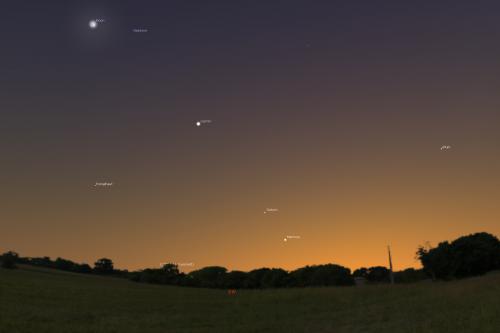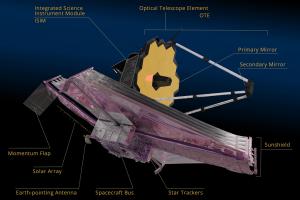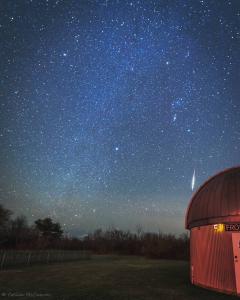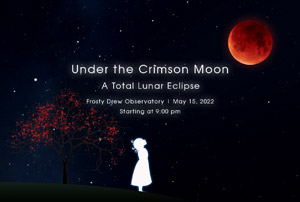Celebration of Space - January 7, 2022
Tonight, January 7, 2022, Mercury will reach the point in its orbit around the Sun where it is at maximum eastern elongation with Earth. What this means is that Mercury will be at its highest point in the evening sky, after sunset, for its current orbital cycle. Being that we are expecting rather clear sky conditions this evening, which is common after a snowstorm, step outside just after 5:00 pm EST and look to the southwest sky. You will notice Jupiter sitting about 28º above the horizon. Below and slightly to the right, you will notice Saturn about 17º over the horizon, and about 5º below Saturn, along the same line with Jupiter, will be a slightly brighter object. That is Mercury. If you have binoculars or a small telescope you just may notice Mercury’s third quarter phase, which will make it look like a small half-Moon. If you miss out on a view tonight, tomorrow night will work out as well, so second chances rock!
On December 25, 2021, the James Webb Space Telescope (JWST) successfully launched into space. Over the past two weeks, the observatory has been deploying many of its operational components. Including the large sun shade and the primary mirror, which will gather all of the light that JWST will collect. The primary mirror, which has 21 feet of aperture, is comprised of eighteen mirror segments. Six of these segments are split among two wings that are collapsible for launch purposes. This morning (Friday, January 7, 2022) the first of the two segments began deployment. The second wing is scheduled to deploy tomorrow, Saturday, January 8, 2022. Once both wings have successfully deployed, the primary mirror will be ready for calibration. Additionally, this is the last component of the observatory that is scheduled for deployment, which will move the status of the JWST to fully deployed. It’s important to note that all of these deployments are occurring while the new telescope is traveling to its destination – the second Lagrange Point (L2), which is nearly 1 million miles beyond the Moon. Even though significant progress has been made over the past couple of weeks, it will be a while before we start seeing fantastic imagery come in from the James Webb. This is due to calibrations and configurations that need to occur once the observatory is in its final orbit. Regardless, it is super exciting to have the JWST in space, and that nearly every big deployment milestone has been met. Keep up with the progress of the telescope as it continues to become operational.
The past two weeks have been quite a wash out as far as weather conditions go for astronomy in Southern New England. We pretty much missed out on Comet C/2021 A1 Leonard’s best viewing, and we missed the annual Quadrantid Meteor Shower. But hey, this is New England, and weather is one of the processes that defines us. Now that the Quadrantid shower has passed we are entering the long lull in meteor activity, as no notable meteor showers will take place until the Lyrid Meteor Shower, which peaks on the morning of April 22, 2022. Now this doesn’t mean that shooting stars will not happen. Earth will still collect about 100 tons of meteors per day. What it means is that there will not be any predicted dates to step outside for shooting star revelries. Once the Lyrids kick in, the 3.5 month lull will come to and end. A fun fact to consider, is that once the Quadrantid Meteor Shower ends, Frosty Drew Observatory and Science Center experiences the least amount of visitors of the entire year until May. This likely has something to do with the long cold of winter, but it’s interesting that this drop occurs alongside the drop in meteor activity.
One of our pastimes at Frosty Drew is using the winter semester break to get all of our events for the coming year listed in events calendars, and on our calendar. Over the past two years, we have not submitted to media calendars due to the ongoing pandemic, with the idea of keeping our visitor numbers low. For 2022, we have a few notable events in store that could be fantastic, if weather permits. The first will be a total lunar eclipse taking place on May 16, 2022, and the New England area is in the prime viewing region! We will also have another total lunar eclipse taking place on November 8, 2022, though this eclipse will happen in the early morning hours, and we will see the total eclipse stage over our location, but the Moon will set during the outset of the partial eclipse stage. As for meteor showers in 2022, the Moon appears to be crashing nearly every notable meteor shower. Regardless, we are excited about the coming year as this will be the year where we really begin to stretch our legs with the new telescope. So make plans to visit Frosty Drew Observatory and Science Center this year and get excited about the cosmos.
- Author:
- Scott MacNeill
- Entry Date:
- Jan 7, 2022
- Published Under:
- Scott MacNeill's Columns





